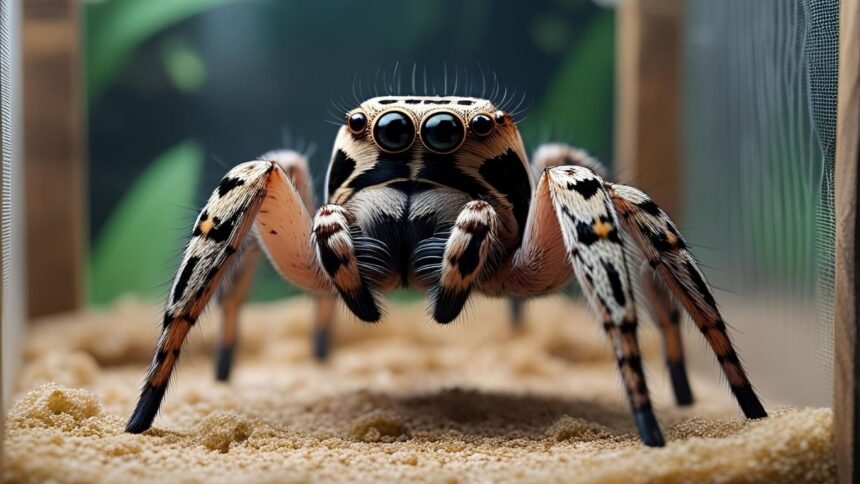Why Proper Enclosure Matters for Jumping Spiders
Unlike many spiders, jumping spiders are very active. They love to jump, climb, and explore. A poor enclosure can stress them, reduce their lifespan, and even cause accidents. A safe jumping spider enclosure provides:
-
Enough space to move
-
Hiding spots for resting
-
Proper airflow
-
A secure lid to prevent escape
When the enclosure feels like a natural habitat, your spider will live longer and show more natural behaviors.
Choosing the Right Size for a Jumping Spider Enclosure
Small vs Large Enclosures
Jumping spiders are small, so they don’t need a huge tank. But too small is also not good. A small box may restrict movement, while an overly large space may make feeding harder.
Best Dimensions for Beginners
A good rule is to choose an enclosure at least 3 times the spider’s leg span in height and width. For most jumping spiders, an enclosure size of 4x4x6 inches is perfect.
Materials for the Perfect Jumping Spider Enclosure
Glass Enclosures
Glass looks beautiful and is easy to clean, but it can be heavy and fragile.
Plastic Enclosures
Plastic boxes are lightweight, safe, and very popular for beginners.
DIY Options
You can make a jumping spider enclosure using food containers, jars, or display boxes – as long as you add ventilation holes and a secure lid.
Essential Features of a Jumping Spider Enclosure
Proper Ventilation
Spiders need fresh air, so always include ventilation holes. Without airflow, mold and humidity problems can occur.
Safe and Secure Lid
Jumping spiders are escape artists. Use a lid with fine mesh or secure clips.
Escape Prevention Tips
Avoid large holes and always check the enclosure after cleaning or feeding.
Substrate and Flooring for Jumping Spider Enclosure
Soil, Coco Fiber, and Moss
The bottom of the enclosure should have a soft substrate like coco fiber, moss, or organic soil. This keeps humidity balanced and makes cleaning easy.
Cleaning and Maintenance
Remove leftover food, dead insects, and mold regularly. A clean jumping spider enclosure prevents health issues.
Decorations and Enrichment Items
Branches, Leaves, and Hides
Add natural branches, sticks, or artificial leaves so the spider can climb and rest.
Safe Plants for Spiders
Live plants like pothos or air plants work well and make the enclosure look beautiful.
Temperature and Humidity in a Jumping Spider Enclosure
Best Temperature Range
Jumping spiders thrive in 70–80°F (21–27°C).
How to Maintain Humidity Levels
Light misting once or twice a week is enough. Avoid overwatering, as too much humidity can harm the spider.
Feeding Inside the Jumping Spider Enclosure
Best Live Food Options
Feed small live insects like fruit flies, crickets, or mealworms.
Safe Feeding Practices
Remove uneaten food after 24 hours to keep the enclosure clean.
Common Mistakes to Avoid
-
Using enclosures that are too large or too small
-
Forgetting to clean regularly
-
Not securing the lid properly
-
Overcrowding the space with decorations
DIY vs Store-Bought Jumping Spider Enclosure
DIY enclosures are budget-friendly and customizable, while store-bought ones often look nicer and are ready to use. The choice depends on your budget and preference.
FAQs
Q1. What is the best size for a jumping spider enclosure?
A 4x4x6 inch enclosure is ideal for most species.
Q2. Do jumping spiders need ventilation holes?
Yes, proper airflow is necessary to prevent mold.
Q3. Can I use real plants inside the enclosure?
Yes, but make sure they are non-toxic and safe.
Q4. How often should I clean the enclosure?
Light cleaning weekly and deep cleaning once a month works best.
Q5. Can jumping spiders escape easily?
Yes, so always use a secure lid.
Q6. Do I need to add water dishes inside?
No, misting lightly is enough for hydration.
Conclusion – Creating a Safe Home for Your Jumping Spider
A jumping spider enclosure doesn’t need to be expensive or complex. What matters is providing the right size, safety, ventilation, and comfort. With simple decorations, proper temperature, and regular cleaning, your spider will thrive in its new home.




